Just two hours before Hurricane Sandy made landfall in New Jersey, Christopher Pagliaro received an email from a couple he designed a home for in Norwalk”™s coastal Rowayton neighborhood.
The multimillion-dollar home was built on a strip of land jutting into the Long Island Sound with water on three sides of the house.
“We have decided to adhere to the evacuation, knowing there is no way out of the house or off the property should the waters rise as expected,” the email said. “We walked out holding hands, kissed each other and walked away crying.”
When Pagliaro designed the house, located in a flood zone, he knew there were risks associated with building in an area expected to get high winds and high tides. So, he built a house to withstand a hurricane.
And it did.
The landscaping was destroyed and the earth surrounding the home eroded, but the house had no damage, said Pagliaro of Bartels-Pagliaro Architects L.L.C., based in South Norwalk.
“It”™s a lovely tale in hindsight,” he said. “When I arrived at the property on Tuesday morning, the gentleman came running out of the house, grabbed my face and kissed me on both cheeks.”
The hurricane destroyed hundreds of homes along the Connecticut shore, including many worth millions of dollars. But much of the damage could have been prevented if recent building standards had been met, Pagliaro said.
In the last 15 years the Federal Emergency Management Agency (FEMA) has made various standards for homes built in designated flood zones.
For instance, the agency stipulates that the first floor of a home shouldn”™t start below a certain elevation and building materials should be flood-damage resistant. But with the majority of the coastal housing stock built in the 1950s, most have not been renovated to meet the requirements, Pagliaro said.
Area houses built and renovated in the last 15 years sustained significantly less damage from Sandy, he said. In fact, none of Pagliaro”™s waterfront homes were damaged and not one flooded in areas that weren”™t designed to take in water, such as garages and crawl spaces.
The first floor of the Rowayton house is 18 feet above sea level. The foundation, windows and walls are designed to tolerate a wave. The property includes seawalls designed to break away in a storm surge, and the elevator in the house automatically stops service when water is sensed below.
The house was one of several homes to receive an award Nov. 14 from the Home Builders and Remodelers Association of Connecticut Inc. (HOBI) and the 22nd house designed by Pagliaro to receive a HOBI award.
Immediately after the storm, Joanne Carroll, producer of the HOBI awards and chairwoman of the association”™s sales and marketing council, said it was unnerving not knowing if the homes that were to receive awards had survived the storm.
“It”™s a very upsetting time,” Carroll said. “As unfortunate as it is, I”™m sure there will be a big increase (in construction) as a result of this and maybe complete rebuilding.”
Pagliaro said he”™s already received inquiries about rebuilding and raising existing homes further above sea level, including one from an association with about two dozen homes. He said it costs at least $100,000 to raise a home, which is a very complex process.
“Right now it might be on their minds as a very important thing to do,” he said.
Some people may decide it”™s not worth lifting a home, but considering the cost of a million dollar home being washed away, the investment may be worth it in the end, Pagliaro said.
“People are going to start to realize that this is what they should be doing or people are going to stop looking to live by the water,” he said. “There”™s a reason why these regulations exist.”






















